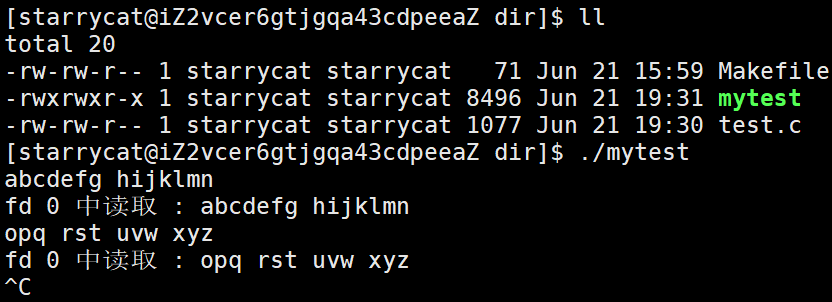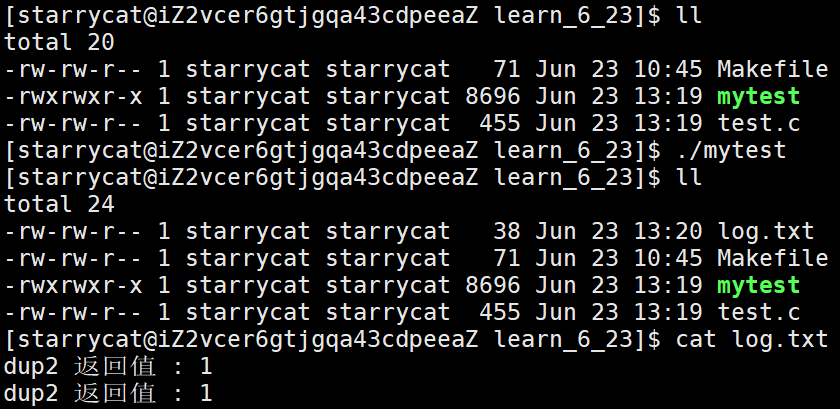文件是在磁盘上创建出来的,当我们想进行文件操作时,根据冯诺依曼体系结构,CPU 只和内存交互,为了可以进行文件操作,应将磁盘中的文件先加载到内存中,加载什么呢?至少要加载文件的某些属性
一个用户可能同时会操作多个文件,并且存在多个用户,因此在某一时间内会存在大量的内存文件,为了管理这些内存文件,需要进行先描述,在组织,操作系统为这些内存文件创建了结构体 file,file 中的属性便从磁盘中加载而来,结构体 file 中还可以存在 struct file* 属性,于是便可以将这些 file 结构体链接起来组成某种数据结构,这样对内存文件的管理,也就转换成了对存储数据类型为结构体 file 的某种数据结构的增删查改
进行文件操作时,用户不是自己操作,而是通过进程对文件操作,因此文件操作的本质其实就是进程的 task_struct 对 文件结构体 file 的操作
一、task_struct 和 file 的关系

task_struct 和 file 的关系中采用了 files_struct 作为中间结构,file_struct 中包含了一个指针数组 fd_array,数组元素存储的是进程加载到内存文件的 file 地址
进程在加载一个文件时,首先操作系统会创建文件结构体 file(如果 file 还未加载到内存),然后会在进程指向的 file_struct 中的 fd_array 中 找到一个下标最小的且没有被使用的位置填充该 file 的地址,进程加载文件完成后,操作系统为了能让进程还可以找到该 file,操作系统给进程提供是 file 地址在 fd_array 中的下标,这个下标我们称之为文件描述符,fd_array 也就称作文件描述符表
二、文件操作的系统调用
- 打开文件:在进程的文件描述符表中填充对应的 file 地址
系统调用 open,头文件 sys/types.h、sys/stat.h、fcntl.h
int open(const char *pathname, int flags);
int open(const char *pathname, int flags, mode_t mode);
返回值:成功返回文件描述符,失败返回 -1
参数:
- pathname:文件路径 + 文件名 + 文件后缀
- flags:位图,传递多个标志位时,标志位之间用 | 连接
- mode:新建文件的权限,受进程的 umask 影响
常用的标志位:
- O_RDONLY:以读的方式打开文件,从文件开始处读取
- O_WRONLY:以写的方式打开文件,从文件开始处写入,不会清空文件
- O_APPEND:需要传递以写的方式打开文件,从文件末尾处写入
- O_TRUNC:需要传递以写的方式打开文件,将文件清空
- O_CREAT:如果文件不存在,则会创建文件,如果传递这个标志,最好也传递 mode 参数
系统调用 umask,头文件 sys/typse.h、sys/stat.h,设置当前进程的 umask 为 mask,该系统调用总是成功,返回设置之前的 umask
// mode_t 类型就是 unsigned int 的 typedef
mode_t umask(mode_t mask);
系统调用 close/ read / write,头文件 unistd.h
// 关闭文件:在进程的文件描述符表中删除对应的 file 地址
// 成功返回 0,失败返回 -1
int close(int fd);
// 向文件描述符 fd 对应的文件最多读取 count 个字节到 buf 中,文件偏移量会增加文件读取到的字节数
// 成功返回读取到的字节数,0 表示未读取到任何内容,表示已经读取到文件结尾,错误返回 -1
ssize_t read(int fd, void *buf, size_t count);
// 向文件描述符 fd 对应的文件最多写入 count 个 buf 中的字符
// 成功返回写入的字节数,0 表示未写入任何内容,错误返回 -1
ssize_t write(int fd, const void *buf, size_t count);
#include <stdio.h>
#include <stdlib.h>
#include <errno.h>
#include <string.h>
#include <assert.h>
#include <sys/types.h>
#include <sys/stat.h>
#include <fcntl.h>
#include <unistd.h>
int main()
{
// O_WRONLY 从文件开始处写入,不会清空文件
// O_APPEND 从文件末尾处写入
// O_RDWR 从文件开始处读取
// int fd = open("log.txt", O_WRONLY | O_CREAT, 0666);
// int fd = open("log.txt", O_WRONLY | O_CREAT | O_APPEND, 0666);
int fd = open("log.txt", O_RDONLY);
if (fd == -1)
{
printf("open error : %s\n", strerror(errno));
exit(1);
}
// R
char buf[128];
while (1)
{
// int count = read(fd, buf, sizeof(buf) - 1);
// if (count <= 0) break;
// buf[count] = '\0';
// printf("%s", buf);
// 按行读取
char ch = 1;
int i = 0;
for (; read(fd, &ch, 1) != 0 && ch != '\n'; ++i)
buf[i] = ch;
if (i == 0) break;
buf[i] = '\0';
printf("%s\n", buf);
sleep(1);
}
// W
// char buf[128];
// int cnt = 10;
// while (cnt)
// {
// snprintf(buf, sizeof(buf), "%s, %d\n", "hello world", cnt);
// ssize_t ret = write(fd, buf, strlen(buf));
// assert(ret != (ssize_t)-1);
// (void)ret;
// cnt--;
// }
// 关闭文件
close(fd);
return 0;
}
三、进程默认打开的三个文件

进程默认打开的三个文件:
- 0:标准输入,对应于键盘文件
- 1:标准输出,对应于显示器文件
- 2:标准错误,对应于显示器文件
#include <stdio.h>
#include <unistd.h>
int main()
{
// 从键盘文件中读取
while (1)
{
char buf[128];
char ch;
int i = 0;
for (; read(0, &ch, 1) != 0 && ch != '\n'; ++i)
buf[i] = ch;
if (i == 0) break;
buf[i] = '\0';
printf("从键盘文件中按行读取 : %s\n", buf);
}
return 0;
}

#include <stdio.h>
#include <string.h>
#include <unistd.h>
int main()
{
// 输出到显示器文件
int cnt = 5;
while (cnt)
{
char buf[128];
snprintf(buf, sizeof(buf), "写入到 fd 1 : %s, %d\n", "hello world", cnt);
write(1, buf, strlen(buf));
snprintf(buf, sizeof(buf), "写入到 fd 2 : %s, %d\n", "hello world", cnt);
write(2, buf, strlen(buf));
cnt--;
printf("\n");
}
}

在进程中打开的第一个文件,返回的文件描述符是 3
#include <stdio.h>
#include <assert.h>
#include <sys/types.h>
#include <sys/stat.h>
#include <fcntl.h>
#include <unistd.h>
int main()
{
// 打开文件
int fd = open("log.txt", O_WRONLY | O_CREAT, 0666);
assert(fd != -1);
printf("fd : %d\n", fd);
// 关闭文件
close(fd);
return 0;
}

四、文件重定向
进程打开新文件时,返回的文件描述符为:文件描述符表中最小并且没有被使用的下标
#include <stdio.h>
#include <sys/types.h>
#include <sys/stat.h>
#include <fcntl.h>
#include <unistd.h>
int main()
{
int fd1 = open("file.txt", O_WRONLY | O_CREAT, 0666);
int fd2 = open("file.txt", O_WRONLY | O_CREAT, 0666);
int fd3 = open("file.txt", O_WRONLY | O_CREAT, 0666);
int fd4 = open("file.txt", O_WRONLY | O_CREAT, 0666);
int fd5 = open("file.txt", O_WRONLY | O_CREAT, 0666);
printf("%d %d %d %d %d\n", fd1, fd2, fd3, fd4, fd5);
close(fd3);
int newFd = open("file.txt", O_WRONLY | O_CREAT, 0666);
printf("%d\n", newFd);
close(fd1);
close(fd2);
close(fd4);
close(fd5);
close(newFd);
return 0;
}

重定向的原理:更改进程的文件描述符表中特定下标指向的文件

实现输出重定向:正常信息输出到 log.normal,异常信息输出到 log.error
#include <stdio.h>
#include <sys/types.h>
#include <sys/stat.h>
#include <fcntl.h>
#include <unistd.h>
int main()
{
// 关闭标准输出,打开 log.normal 文件, 此时 log.normal 的文件描述符 为 1
close(1);
int normalfd = open("log.normal", O_WRONLY | O_CREAT, 0666);
// 关闭标准错误,打开 log.error 文件,此时 log.error 的文件描述符为 2
close(2);
int errorfd = open("log.error", O_WRONLY | O_CREAT, 0666);
// 写入到标准输出,即写入到 1 号文件描述符,即写入到 log.normal 文件
printf("log.normal fd : %d\n", normalfd);
printf("log.error fd : %d\n", errorfd);
// 写入到标准错误,即写入到 2 号文件描述符,即写入到 log.error 文件
// 以读方式打开一个不存在的文件,模拟错误信息
int fd = open("abc.txt", O_RDONLY);
if (fd == -1) perror("open");
return 0;
}

系统调用 dup2,头文件 unistd.h
// 将 oldfd 拷贝给 newfd,必要时先关闭 newfd
// 即 fd_arrray[newfd] = fd_array[oldfd]
// 成功返回新的文件描述符,失败返回 -1
int dup2(int oldfd, int newfd);

#include <stdio.h>
#include <string.h>
#include <unistd.h>
#include <sys/types.h>
#include <sys/stat.h>
#include <fcntl.h>
int main()
{
int fd = open("log.txt", O_WRONLY | O_CREAT, 0666);
// 重定向 fd_array[1] = fd_array[fd]
int ret_fd = dup2(fd, 1);
char buf[128];
snprintf(buf, sizeof(buf), "dup2 返回值 : %d\n", ret_fd);
write(1, buf, strlen(buf));
write(fd, buf, strlen(buf));
close(fd);
return 0;
}

五、Linux 下一切皆文件
通过 file 结构体用户可以像文件一样看待 Linux 中的硬件

六、缓冲区
在调用向文件写入数据的库函数时,数据并不是立刻写入到文件,而是先写到语言提供的缓冲区中
#include <stdio.h>
#include <unistd.h>
int main()
{
// 写入到显示器文件
for (int i = 0; i < 3; ++i)
{
printf("you can see me? ");
sleep(1);
}
printf("\n");
return 0;
}
程序并不会一秒一秒的显示 you can see me?,而是 3 秒后全部显示

缓冲区的作用是为了防止频繁的调用系统调用而花费太多时间,最好可以尽量少的调用系统调用就可以将所有数据写入到 file 的缓冲区中

对于不同的文件,语言的缓冲区采用的刷新策略有三种:
- 无缓冲:不提供缓冲区,直接调用系统调用写到 file 的缓冲区
- 行缓冲:遇到 \n 时,调用系统调用写到 file 的缓冲区
- 全缓冲:缓冲区写满时,调用系统调用写到 file 的缓冲区
语言中对于显示器文件采用的是行缓冲,普通文件采用的是全缓冲,而 file 的缓冲区的刷新策略是由操作系统自主决定的
#include <stdio.h>
#include <string.h>
#include <unistd.h>
int main()
{
// C语言库函数
fprintf(stdout, "hello fprintf\n");
// 系统调用
const char* msg = "hello write\n";
write(1, msg, strlen(msg));
// 创建子进程
fork();
return 0;
}
重定向前后输出的数据不一样

-
输出重定向前,fprintf 写入到显示器文件中,此时采用的是行缓冲,因此在 fork 之前,缓冲区的数据已经被刷新到 file 的缓冲区了
-
输出重定向后,fprintf 写入到普通文件中,此时采用的是全缓冲,因此在 fork 之前,缓冲区的数据并没有刷新,于是 fork 之后,父子进程结束时都会刷新缓冲区也就造成了这种现象
-
write 直接写入到 file 的缓冲区中,因此 fork 和 输出重定向 对 write 不受影响






















 1206
1206











 被折叠的 条评论
为什么被折叠?
被折叠的 条评论
为什么被折叠?








